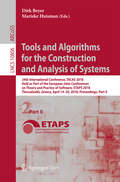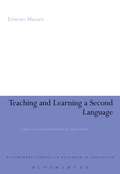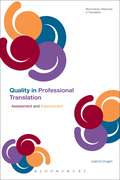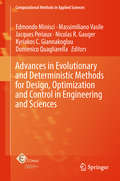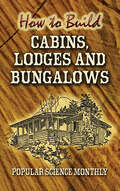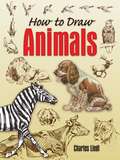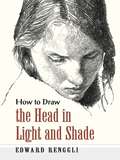- Table View
- List View
Tools and Algorithms for the Construction and Analysis of Systems: 24th International Conference, TACAS 2018, Held as Part of the European Joint Conferences on Theory and Practice of Software, ETAPS 2018, Thessaloniki, Greece, April 14-20, 2018, Proceedings, Part II (Lecture Notes in Computer Science #10806)
by Dirk Beyer Marieke HuismanThis book is Open Access under a CC BY licence.The LNCS 10805 and 10806 proceedings set constitutes the proceedings of the 24th International Conference on Tools and Algorithms for the Construction and Analysis of Systems, TACAS 2018, which took place in Thessaloniki, Greece, in April 2018, held as part of the European Joint Conference on Theory and Practice of Software, ETAPS 2018.The total of 43 full and 11 short papers presented in these volumes was carefully reviewed and selected from 154submissions. The papers are organized in topical sections as follows:Part I: theorem proving; SAT and SMT I; deductive verification; software verification and optimization; model checking; and machine learning. Part II: concurrent and distributed systems; SAT and SMT II; security and reactive systems; static and dynamic program analysis; hybrid and stochastic systems; temporal logic and mu-calculus; 7th Competition on Software Verification – SV-COMP.
Fratricide in Battle: (Un)Friendly Fire (Bloomsbury Studies in Military History)
by Charles KirkeFratricide, or 'Friendly Fire', is a persistent and unwelcome feature in war. Can it be avoided? How can it be properly understood?Beginning with a historical analysis, Fratricide in Battle examines all aspects of the problem, covering both human and technical factors, before looking at a range of measures currently in use to tackle the issue.Charles Kirke brings together an international group of experts in the field, from both military and academic backgrounds, to provide a thorough examination of this crucial subject. Taken together, their contributions offer a comprehensive understanding of fratricide in its historical context and suggest important lessons for future generations.
Free Will and Continental Philosophy: The Death without Meaning (Continuum Studies in Continental Philosophy)
by David Edward RoseFree Will and Continental Philosophy explores the concepts of free-will and self-determination in the Continental philosophical tradition. David Rose examines the ways in which Continental philosophy offers a viable alternative to the hegemonic scientistic approach taken by analytic philosophy. Rose claims that the problem of free-will is only a problem if one makes an unnecessary assumption consistent with scientific rationalism. In the sphere of human action we assume that, since action is a physical event, it must be reducible to the laws and concepts of science. Hence, the problematic nature of free will raises its head, since the concept of free will is intrinsically contradictory to such a reductionist outlook. This book suggests that the Continental thinkers offer a compelling alternative by concentrating on the phenomena of human action and self-determination in order to offer the truth of freedom in different terms. Thus Rose offers a revealing investigation into the appropriate concepts and categories of human freedom and action.
Teaching and Learning a Second Language: A Guide to Recent Research and its Applications
by Ernesto MacaroThere is increasingly wide agreement among teachers, researchers, inspectors, advisers and policy-makers that both teaching and research will benefit from being brought closer together. But how can this be achieved? Hard-pressed practioners cannot be expected to review a constant flow of conference papers, journals and other publications, even if such items were accessibly written. This unique book synthesizes relevant research findings for the professional practioner and highlights their implications for the quality of teaching and learning. Whether you are a teacher looking to improve your practice or a researcher looking for a concise overview of the literature, this book will prove a valuable acquisition.
Proverbs (Old Testament Guides)
by James D. MartinThis addition to Sheffield's acclaimed Old Testament Guides series introduces students not only to Proverbs but also to the genre of 'wisdom literature' in general (dealing with such questions as the origin and location of 'wisdom' in ancient Israel). Martin discusses the structure of the book of Proverbs as a whole, provides a guided reading to the more or less sustained discourses in chapters 1-9 and to the collections of proverb-type sentences in the remaining chapters, and considers the relationship of Proverbs to other ancient Near Eastern literature. The Guide is completed by essays on 'The Feminine in the Book of Proverbs' and 'Wisdom and Theology'.
Why Truth Matters
by Jeremy Stangroom Ophelia Benson Truth has always been a central preoccupation of philosophy in allits forms and traditions. Yet in the late twentieth century truth became suddenly rather unfashionable. The precedence given to assortedpolitical and ideological agendas, along with the rise of relativism, postmodernism and pseudoscience in academia, led to a decline both of truth as a serious subject, and an intellectual tradition thatbegan with the Enlightenment.Why Truth Matters is a timely, incisive and entertaining look at how and why modern thought and culture lost sight of the importance of truth. It is also an eloquent and inspiring argument for restoring truth to its rightful place. Jeremy Stangroom and Ophelia Benson, editors of the successful butterfliesandwheels website-itself established to "fight fashionable nonsense"-identify and debunk such senselessness, and the spurious claims made for it, in all its forms. Their account ranges over religious fundamentalism, Holocaust denial, the challenges of postmodernism and deconstruction, the wilful misinterpretation of evolutionary biology, identity politics and wishful thinking.Why Truth Matters is both a rallying cry for the enlightened vision and an essential read for anyone who's everbeen bored, frustrated, bewildered or plain enraged by the worst excesses of the fashionable intelligentsia.
Modeling of Column Apparatus Processes (Heat and Mass Transfer)
by Christo Boyadjiev Maria Doichinova Boyan Boyadjiev Petya Popova-KrumovaThis new edition includes brand-new developments in the modeling of processes in the column apparatuses. It analyzes the radial velocity component and axial variation in the axial velocity in the column. These models are described in five new chapters. The book presents models of chemical and interphase mass transfer processes in industrial column apparatuses, using convection-diffusion and average-concentration models. It also introduces average concentration models for quantitative analysis, which use the average values of the velocity and concentration over the cross-sectional area of the column. The new models are used to analyze a broad range of processes (simple and complex chemical reactions, physical and chemical absorption, physical and chemical adsorption, catalytic reactions in the cases of physical and chemical adsorption mechanism), and make it possible to model sulfur dioxide gas purification processes.
Safety-Critical Electrical Drives: Topologies, Reliability, Performance (SpringerBriefs in Electrical and Computer Engineering)
by Igor Bolvashenkov Hans-Georg Herzog Ilia Frenkel Lev Khvatskin Anatoly LisnianskiThis book focuses on one of the most important aspects of electrical propulsion systems – the creation of highly reliable safety-critical traction electrical drives. It discusses the methods and models for analysis and optimization of reliability and fault tolerance indices, based on which, it proposes and assesses methods for improving the availability, fault tolerance and performance of traction electric drives.
Photochemistry: A Modern Theoretical Perspective (Theoretical Chemistry and Computational Modelling)
by Maurizio Persico Giovanni GranucciThis book offers an introduction to photochemistry for students with a minimal background in physical chemistry and molecular quantum mechanics. The focus is from a theoretical perspective and highlights excited state dynamics. The authors, experienced lecturers, describe the main concepts in photochemical and photophysical processes that are used as a basis to interpret classical steady-state experimental results (essentially product branching ratios and quantum yields) and the most advanced time-resolved techniques. A significant portion of the content is devoted to the computational techniques present in quantum chemistry and molecular dynamics.With its short summaries, questions and exercises, this book is aimed at graduate students, while its theoretical focus differentiates it from most introductory textbooks on photochemistry.
Intelligence Measurement and School Performance in Latin America: A Report of the Study of Latin American Intelligence Project
by Carmen Flores-Mendoza Rubén Ardila Ricardo Rosas María Emilia Lucio Miguel Gallegos Norma Reátegui ColaretaThis book presents the results of the most complete and updated assessment of cognitive resources of students in Latin America: the Study of Latin American Intelligence (SLATINT). During four years, top researchers of the region used a standardized set of cognitive measures to assess 4,000 students aged between 14 and 15 years from six countries: Brazil, Argentina, Mexico, Chile, Colombia and Peru. The data collected and now analyzed in this volume is a first step to understand the human cognitive capital of the region, a crucial resource for any country today. Intelligence research has shown that the cognitive skills of a population are strongly associated with the school performance of its students and the development of a nation. This makes Intelligence Measurement and School Performance in Latin America a valuable tool both for Latin American researchers and authorities engaged in the improvement of each country’s human resources and for psychologists, educators and other social scientists dedicated to the study of the impact of intelligence in the development of nations.
Fault Diagnosis Inverse Problems: Solution with Metaheuristics (Studies in Computational Intelligence #763)
by Lídice Camps Echevarría Orestes Llanes Santiago Haroldo Fraga Campos Velho Antônio José Silva NetoThis book presents a methodology based on inverse problems for use in solutions for fault diagnosis in control systems, combining tools from mathematics, physics, computational and mathematical modeling, optimization and computational intelligence. This methodology, known as fault diagnosis – inverse problem methodology or FD-IPM, unifies the results of several years of work of the authors in the fields of fault detection and isolation (FDI), inverse problems and optimization. The book clearly and systematically presents the main ideas, concepts and results obtained in recent years. By formulating fault diagnosis as an inverse problem, and by solving it using metaheuristics, the authors offer researchers and students a fresh, interdisciplinary perspective for problem solving in these fields. Graduate courses in engineering, applied mathematics and computing also benefit from this work.
Jesus: Luke's Account
by Anselm Grün"I want to connect what concerns people today with what it was about Jesus that fascinated Luke, as a man of his lifetime... I want every reader to be guided by Luke to Jesus, to gain new insights into Jesus, and to discover in him the one who gives meaning to our existence, heals our wounds and leads us to true life." In Jesus: The Image of Humanity, best selling author Anslem Grün writes an introduction to the Gospel of Luke that will inspire those who find it difficult to encounter the real Jesus in the writings of the New Testament. He shows the Jesus of Luke's Gospel to be the key to a spiritually fruitful life, something many biblical exegetes fail to do. He pierces through alienating and inherited impressions of the text to show that what Luke is giving us is a record of his own experience of Jesus. He sees the Gospel as an expertly composed, entertaining, and valuable piece of publicity on behalf of the Jesus movement; and its message is as life changing in the twenty-first century as it was in the first century.
Catherine of Siena (Outstanding Christian Thinkers)
by Guiliana CavalliniFrom her earliest years, Catherine of Siena (1347-80) was griped by the mystery of God incarnate. This was the beginning of a life-long love story, a life-long conversion in which Christ spoke to Catherine and she communicated the truth of his being to the world of her time. Creation itself, she says, is an act of love, and Christ is the bridge by which human beings come to realize their full humanity, their inmost nature, which is to love.Mystic, champion of the poor and Church reformer, Catherine was declared a Doctor of the Church in 1970. She was unable to write until she was thirty, but she corresponded with Popes, Cardinals, scholars and civic authorities. She was a true daughter of the fourteenth century, famous in her own life time, and yet her thinking and her work seem entirely relevant in the political and ecclesial context of our own time. When Pope Paul VI was asked whether she should be considered a politician, his answer was yes, but in a thoroughly spiritual way; this, he said, is why 'the teaching of this singular woman politician is still meaningful and valuable'.
Values in Education (Continuum Studies in Research in Education)
by Graham Haydon?What are the fundamental aims and values underlying education? ?What values should education try to promote in a world of value pluralism??What is morality, and should schools teach it??In a secular society, how should schools treat the links between morality and religion??How should values enter into professional education and educational leadership?This book, an updated edition of Teaching about Values, will help the reader to think about these questions and many others concerning values in education. Drawing on philosophy without assuming knowledge of the subject, it is for teachers, students of education and anyone who recognises the importance of values in education.
Quality In Professional Translation: Assessment and Improvement (Bloomsbury Advances in Translation)
by Joanna DruganHow do translation companies, multilingual international organizations and individual translators measure and improve the quality of their translations? This book reports on the range of approaches to quality assurance across the translation industry, from Norway to China, from the individual freelance working in a home office to the largest translation supplier in the world. Best practice is outlined for a range of translation scenarios, enabling readers to learn from others' experience - and mistakes. The author also draws on over a decade's experience to outline the potential to improve quality by exploiting modern technological support tools such as translation memory software.New and experienced translators will gain understanding of what employers expect (and reward); translation companies can learn how their peers and rivals manage this sensitive area of their work; clients will find out what levels of quality they can expect; and academics are provided with an illuminating insight into how quality is assessed and guaranteed in the profession today.
Basics of Mechanical Ventilation
by Hooman PoorThis book is a practical and easily understandable guide for mechanical ventilation. With a focus on the basics, this text begins with a detailed account of the mechanisms of spontaneous breathing as a reference point to then describe how a ventilator actually works and how to effectively use it in practice. The text then details: the various modes of ventilation commonly used in clinical practice; patient-ventilator interactions and dyssynchrony; how to approach a patient on the ventilator with respiratory decompensation; the optimal ventilator management for common disease states like acute respiratory distress syndrome and obstructive lung disease; the process of ventilator weaning; and hemodynamic effects of mechanical ventilation. Written for medical students, residents, and practicing physicians in a variety of different specialties (including internal medicine, critical care, surgery and anesthesiology), this book will instruct readers on how to effectively manage a ventilator, as well as explain the underlying interactions between it and the critically ill patient.
Archaeological Human Remains: Legacies of Imperialism, Communism and Colonialism (Springerbriefs In Archaeology Ser.)
by Barra O'Donnabhain Maria Cecilia LozadaThis book expands on Archaeological Human Remains: Global Perspectives that was published in the Springer Briefs series in 2014 and which had a strong focus on post-colonial countries. In the current volume, the editors include papers that deal with non-Anglophone European traditions such as Portugal, Germany and France. In addition, authors continue the exploration of osteological trajectories that are not well-documented in the West, such as Senegal, China and Russia. The lasting legacies of imperialism, communism and colonialism are apparent as the authors of the individual country profiles examine the historical roots of the study of archaeological human remains and the challenges encountered while also considering the likely future directions likely of this multi-faceted discipline in different world areas.
Advances in Evolutionary and Deterministic Methods for Design, Optimization and Control in Engineering and Sciences (Computational Methods in Applied Sciences #48)
by Edmondo Minisci Massimiliano Vasile Jacques Periaux Nicolas R. Gauger Kyriakos C. Giannakoglou Domenico QuagliarellaThis volume presents up-to-date material on the state of the art in evolutionary and deterministic methods for design, optimization and control with applications to industrial and societal problems from Europe, Asia, and America.EUROGEN 2015 was the 11th of a series of International Conferences devoted to bringing together specialists from universities, research institutions and industries developing or applying evolutionary and deterministic methods in design optimization, with emphasis on solving industrial and societal problems. The conference was organised around a number of parallel symposia, regular sessions, and keynote lectures focused on surrogate-based optimization in aerodynamic design, adjoint methods for steady & unsteady optimization, multi-disciplinary design optimization, holistic optimization in marine design, game strategies combined with evolutionary computation, optimization under uncertainty, topology optimization, optimal planning, shape optimization, and production scheduling.
Reframing Critical, Literary, and Cultural Theories: Thought on the Edge
by Nicoletta PiredduThis book participates in the ongoing debate about the alleged “death of theory” and the current post-theoretical condition, arguing that the “finitude” of theoretical projects does not mean “end”, but rather contingency and transformation of thinking, beyond irreconcilable doctrines. Contributors from different cultural and scholarly backgrounds and based in three different continents propose new areas of investigation and interpretive possibilities, reopening dialogues with past and present discourses from a plurality of perspectives and locations. After a first section that reassesses the status and scopes of critique, theory, and literature, the book foregrounds new or neglected critical vocabulary, literary paradigms, and narrative patterns to reread texts at the intersection with other branches of the humanities—history, philosophy, religion, and pedagogy. It then explores geopolitical, cultural, and epistemological domains that have been historically and ideologically overdetermined (such as postsocialist, postcolonial, and cosmopolitan spaces), recodifying them as unstable sites of both conflicts and convergences. By acknowledging the spatio-temporal and cultural delimitations of any intellectual practice, the book creates awareness of our own partiality and incompleteness, but treats boundaries as zones of contact, exchange, and conceptual mobility that promote crossings and connections.
Reframing Critical, Literary, and Cultural Theories: Thought on the Edge
by Nicoletta PiredduThis book participates in the ongoing debate about the alleged “death of theory” and the current post-theoretical condition, arguing that the “finitude” of theoretical projects does not mean “end”, but rather contingency and transformation of thinking, beyond irreconcilable doctrines. Contributors from different cultural and scholarly backgrounds and based in three different continents propose new areas of investigation and interpretive possibilities, reopening dialogues with past and present discourses from a plurality of perspectives and locations. After a first section that reassesses the status and scopes of critique, theory, and literature, the book foregrounds new or neglected critical vocabulary, literary paradigms, and narrative patterns to reread texts at the intersection with other branches of the humanities—history, philosophy, religion, and pedagogy. It then explores geopolitical, cultural, and epistemological domains that have been historically and ideologically overdetermined (such as postsocialist, postcolonial, and cosmopolitan spaces), recodifying them as unstable sites of both conflicts and convergences. By acknowledging the spatio-temporal and cultural delimitations of any intellectual practice, the book creates awareness of our own partiality and incompleteness, but treats boundaries as zones of contact, exchange, and conceptual mobility that promote crossings and connections.
Excel 2016 in Applied Statistics for High School Students: A Guide to Solving Practical Problems (Excel for Statistics)
by Thomas J. QuirkThis textbook is a step-by-step guide for high school, community college, or undergraduate students who are taking a course in applied statistics and wish to learn how to use Excel to solve statistical problems. All of the statistics problems in this book will come from the following fields of study: business, education, psychology, marketing, engineering and advertising. Students will learn how to perform key statistical tests in Excel without being overwhelmed by statistical theory. Each chapter briefly explains a topic and then demonstrates how to use Excel commands and formulas to solve specific statistics problems. This book gives practice in using Excel in two different ways: (1) writing formulas (e.g., confidence interval about the mean, one-group t-test, two-group t-test, correlation) and (2) using Excel’s drop-down formula menus (e.g., simple linear regression, multiple correlations and multiple regression, and one-way ANOVA). Three practice problems are provided at the end of each chapter, along with their solutions in an Appendix. An additional Practice Test allows readers to test their understanding of each chapter by attempting to solve a specific statistics problem using Excel; the solution to each of these problems is also given in an Appendix. This book is a tool that can be used either by itself or along with any good statistics book. Includes 166 illustrations in color Suitable for high school and community college students.
The History of Chivalry and Armour: With 60 Full-Color Plates
by F. KottenkampFrom his earliest years and throughout his training as squire, a young knight was rigorously instructed in the use of arms. Competing in tournaments honed the skills of knights and squires alike, and provided a keen development of military prowess beyond the dangers of the battlefield. As improvements in defensive armour and weaponry were made, the elaborate decoration of arms also flourished. The trials and jousts of the tournament became more than just a stage for combat as the weaponry itself evolved into a stunning art form. A visual and literary feast, The History of Chivalry and Armour is a study of medieval knights in all their grandeur, fully displaying their instruments of siege, ornaments, and entertainments. Reproduced from a rare nineteenth-century masterpiece, here are the origins, codes, and practices of knighthood, alongside magnificent hand-colored engravings of armour, weapons, and the men who bore them. Enjoy breathtaking shields, helmets, and horse coverings. Revel in meticulously rendered lances, spears, and spiked clubs, as well as incredibly engineered mobile siege towers and muskets. The richly decorated equipment used in warfare and jousting shine brightly in this treasury, accompanied by authentic literature from poets and troubadors of the age.
How to Build Cabins, Lodges and Bungalows
by Popular Science Monthly"Nothing could be more American than the simple cabin. Not many generations ago, it was the backbone of American life, the headquarters of that important unit, the home. It provided shelter, protection, and a foundation upon which to build a great empire. The pioneer cabin was, in other words, a necessity." -- From the IntroductionOnce regarded as a safe haven and a vital source of security, the little cabin in the country is today more closely associated with leisurely activities -- a vacation spot and even a health investment. First published in the 1930s, this helpful guide was designed to provide vacation home builders with all the information they needed to construct, decorate, and furnish a rustic little cottage. Floor plans and outlines of necessary materials are included, as are tips on constructing foundations, porches, doors, windows, fireplaces, and other structural elements. There are even suggestions for furnishing and beautifying your cabin.A useful how-to manual, offering straightforward advice on the building process from foundation to roof, this practical book can also be enjoyed as an entertaining look at lifestyle elements of the early twentieth century.
How to Draw Animals
by Charles LiedlDrawing animals requires fast thinking and quick execution. Unlike artists of landscapes or still-life, the animal illustrator must adhere to this golden rule: observe much and long and draw quick and little. This respected guidebook, written by renowned wildlife illustrator Charles Liedl, shows you how. In How to Draw Animals, artists of every level will learn the techniques for portraying animals accurately and gracefully, whether the creatures are in action or repose. Keen advice on the importance of visually mastering the subject's anatomy gives way to invaluable guidance on line sketching, outlining, shading, form, tone, and detail. More than 100 expert illustrations include muscular and skeletal characteristics, and detail the development process in creating an enormous variety of wild and domestic breeds: horses, deer, game birds, dogs, cats, rabbits, foxes, buffalo, zebras, tigers, wolves, and many more. The author also provides tips on the best media to use and how to use them, as well as how to guide an animal to turn or resume a pose. A time-honored art instruction guide, both motivational and inspirational, this volume is a must-have for the bookshelves of every artist.
How to Draw the Head in Light and Shade
by Edward RenggliIn this invaluable guide, the human head is carefully studied in every conceivable pose and illumination, from bright light to gentle shade. Dramatic drawings of individuals from a variety of age groups are included, revealing the variations in features and bone structures. Beginning with the essential constructive lines of each drawing, the book highlights methods for perspective, proportion, foreshortening, and proper shading. As the sketch's details are fleshed out, so too are the energy and personality of each subject.For both beginners and professionals, How to Draw the Head in Light and Shade provides a powerful foundation for building and realistically depicting the head in sketching, portraiture, and painting.
